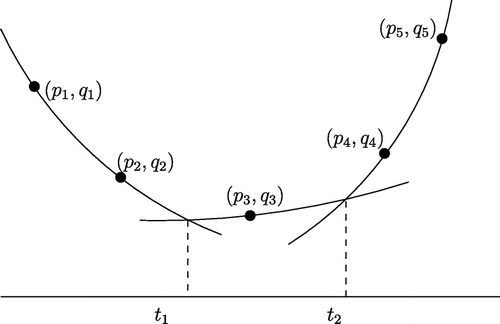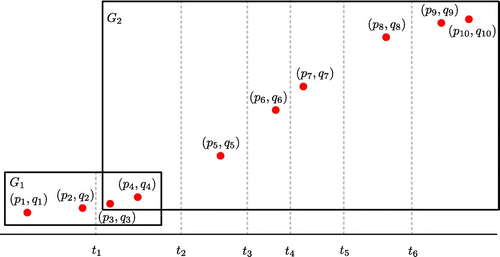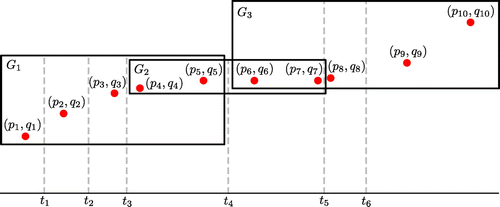 ?Mathematical formulae have been encoded as MathML and are displayed in this HTML version using MathJax in order to improve their display. Uncheck the box to turn MathJax off. This feature requires Javascript. Click on a formula to zoom.
?Mathematical formulae have been encoded as MathML and are displayed in this HTML version using MathJax in order to improve their display. Uncheck the box to turn MathJax off. This feature requires Javascript. Click on a formula to zoom.Abstract
In many mathematical models with complex parameter functions, it is critical to suggest a strategy for estimating those functions. This paper considers the problem of fitting parameter functions to given data by using a finite number of piecewise functions. Here, the primary aim is to propose several necessary and sufficient conditions that can guarantee the existence of parameter functions. With these criteria, the paper provides an algorithm for solving the parameter estimation problem efficiently. Numerical examples verify that the proposed algorithm is effective in estimating parameter functions in differential equations.
1 Introduction
Mathematical modelling using a system of differential equations with a set of parameters has been widely used in most scientific fields, including physics, chemistry, biology, earth and environmental sciences, and engineering. Mathematical problems related with such parameter-dependent differential equations can be classified into forward and inverse problems. Forward problems need the analysis and simulation of the model for given parameter values, whereas inverse problems require the estimation of parameters based on the measurement of output variables. The latter have received considerable attention in the last three decades (see e.g. [Citation1, Citation2] and the references therein). As statistical approaches to parameter estimation problems, nonlinear regression and other data-fitting methods have been widely used.[Citation3–Citation7]
Among various important problems related to parameter estimation, this paper is particularly interested in the problem of fitting parameter functions to given data by using a finite number of piecewise functions. The primary aim of the paper is to propose some conditions for the existence of parameter functions and introduce an efficient algorithm for estimating these functions. The number of subintervals and the type of basis function in each subinterval are not known a priori, and therefore the main concern is how the number of subintervals and the basis function can be determined and how time nodes can be optimally found for each subinterval.
This paper begins with linear stage-structured differential equations whose parameter functions can be approximated by piecewise constants, and other types of basis functions for approximating parameter functions and nonlinear differential equations with noisy data are left to future research. For a given data-set, the focus is on finding a piecewise constant parameter function in a differential equation to interpolate the data. A necessary and sufficient condition for the existence and uniqueness of the piecewise constant parameter function when subintervals are known is addressed first. In addition, several criteria for determining time nodes and then parameter functions when subintervals are yet to be determined are proposed. These criteria are provided by a -test function in Section 2. An algorithm is suggested to determine time nodes and coefficients for each subinterval optimally with the given data-set and the number of subintervals. Several numerical experiments demonstrate that the algorithm is effective in estimating parameter functions. Further, the solution of the linear stage-structured differential equation with the estimated parameter function provides a good approximation for the solution of the nonlinear differential equation.
The rest of this paper proceeds as follows: Section 2 starts with a formulation of the problem of estimating parameter functions with a linear stage-structured differential equation. A -test function is defined to determine whether there exist suitable solutions of the differential equation to interpolate a set of given data. Section 3 presents the necessary and sufficient conditions for the given data-set to solve the problem of estimating parameter functions when time nodes of subintervals are known. Section 4 derives the conditions by using the
-test function for determining parameter functions when time nodes of subintervals are yet to be determined. Section 5 introduces an algorithm for determining parameter functions based on an optimization problem, and Section 6 presents the numerical results for estimated parameter functions and their corresponding solutions based on the proposed algorithm.
2 Parameter estimation problem
2.1 Motivation
Numerous biological phenomena can be described by stage-structured modelling. For instance, growth rates of most fish species are sensitive to seasonal effects, mainly to temperature changes, and it is well known that there is a strong relationship between specific growth rates and temperature for most populations of bacteria (see e.g. [Citation8–Citation10] and the references therein). In addition, many delay differential equations with a stage structure can be found in the literature.[Citation11–Citation15]
For the given data-set the following stage-structured differential equation is considered:
with the parameter function
1
1 where the number of intervals
, the node
and the parameter
,
are to be determined by assuming that
Here,
, and
depend on the differential equation and the given data-set
.
2.2 Linear case
This paper focuses on linear stage-structured differential equations by emphasizing the relationship between the parameter function and the data-set. Nonlinear differential equations are left to future research.
Now consider the following estimation problem: For a set of given data find
in the form of (Equation1
1
1 ) such that
2a
2a
2b
2b
Note that the solution of (2) can be given by
3
3 when the parameter function
in (Equation1
1
1 ) is known.
Because most physical data have positive values, solutions of Equation (Equation2a2a
2a ) are assumed to be positive and data-sets are restricted to cases such as those described in Definition 2.1.
Definition 2.1
The data-set is called positively well-posed if
has the following two properties:
| (i) |
| ||||
| (ii) | |||||
If there is only a single subinterval, then the necessary and sufficient condition for the constant function to be uniquely determined in the interval is summarized in the following lemma:
Lemma 2.2
Suppose that there is a given data set that is positively well-posed in a single interval
. Then the constant function
and the solution
satisfying (2) can be uniquely determined if and only if
Proof
Suppose that satisfies
Then the given data-set
must satisfy
That is,
are collinear. The existence and uniqueness of
and
are equivalent to
Before describing the relationship between data points, the -test function is first defined.
Definition 2.3
Define the -test function
by
Proposition 2.4
Suppose that . If the
-test function C is positive (or negative), then there exists a log-concave (or log-convex) function that passes through
,
and
. In addition, the following properties hold:
4
4
Proof
Note that the -test function
can be rewritten as
Suppose that
. Then
which implies the existence of a concave quadratic function that passes through
and
The case of
is similar. Equation (Equation4
4
4 ) follows immediately from the definition of the
-test function
.
Remark 2.5
implies that
and
lie on one exponential curve:
where
Equivalently, the exponential curve can be rewritten as
Definition 2.6
The data-set is called reducible for the parameter estimation problem if and only if there exist three adjacent data points
such that
Otherwise, the set of data
is called irreducible.
Remark 2.7
Suppose that the given data-set is positively well-posed and irreducible in the interval
with the partition
. Then every subinterval contains no more than two data points if the data-set determines the parameter function
to be uniquely fulfilling (2).
3 The case of known subintervals
This section starts by looking at the case in which (
), are given. The following theorem provides the conditions for the given data-set to guarantee the existence and uniqueness of the parameter function
and the corresponding solution
of (2).
Theorem 3.1
Let Suppose that the given data set
is positively well-posed and let
be given time nodes of
Then there exists a unique parameter function
and its solution
that satisfy (2) if and only if the following condition holds:
If any interval contains two data points, then
data points are located in
for any
.
Proof
Rearrange data points as follows:
| (i) | For | ||||
| (ii) | For | ||||
| (iii) | For | ||||
With some elementary operations, can be transformed into the following matrix
where
denotes a zero block matrix and
and
Since
the following can be obtained by recalling
:
Based on the above, in the case of
,
, and thus
is not invertible. Therefore, there is a need for the condition
with
to make
invertible.
Remark 3.2
| (i) | Theorem 3.1 provides the necessary and sufficient condition for data and subintervals for the determination of a parameter function | ||||
| (ii) | In the case of | ||||
| (iii) | In the case of | ||||
Remark 3.3
Let a given data-set that is positively well posed and
be given time nodes in
with
Suppose that there are two consecutive subintervals
and
containing two data points in each subinterval. Then the parameter function
cannot be determined uniquely. Indeed, for
to be determined uniquely, Theorem 3.1 requires that
and
contain
and
data points, respectively, which leads to a contradiction.
4 The case of subintervals not yet determined
The previous section describes the necessary and sufficient condition for a data-set to determine a parameter function and its corresponding solution uniquely when The parameter function estimation problem is over-determined in the case of
If the problem is over-determined with too much information, then a particular solution may not exist. As one way to address this problem, the number of unknown parameters can be increased by assuming that time nodes
need to be determined. Suppose a given data-set
is positively well-posed and irreducible. Then every subinterval should have at most two data points. Note that in each subinterval, the constant value of the parameter
and its corresponding solution
is uniquely determined by two data points. Therefore, to determine the parameter function for the whole interval, the following types of contiguous subintervals need to be considered:
| (T1) | The first and last subintervals in this category both contain two data points, whereas all other subintervals contain only one data point, | ||||
| (T2) | Only the first or last subinterval in this category contains two data points, whereas all other subintervals contain only one data point. | ||||
Figure 1. For given data with can be uniquely determined in case (a), whereas
cannot be determined in case (b).

Lemma 4.1
Assume that and
are any nonzero real numbers. Then the following two conditions are equivalent:
| (i) |
| ||||
| (ii) |
| ||||
Proof
Suppose (ii) is not true, that is, Then
which implies that (i) is not true. By contrapositive, this completes the proof.
Lemma 4.2
Suppose that and the given data set
is positively well-posed and irreducible over the whole interval
Then there exist unique
and the corresponding parameters
and
such that the function
given by (Equation3
3
3 ) satisfies (2) if and only if
Proof
Suppose that there exist and the corresponding parameters
and
such that the function
given by (Equation3
3
3 ) satisfies (2). Then we have
and (Equation2b
2b
2b ) also requires the following relationships:
The parameter values of
and
and the logarithmic values of
and
can be determined in terms of
by solving the above equations:
7
7 From the continuity condition
, we have
8
8 Combining (Equation7
7
7 ) and (Equation8
8
8 ) gives
9
9 and finally,
Now the condition in which
lies between
and
needs to be derived (see Figure ). This condition can be restated as
and a direct calculation gives
Note that the denominator is not zero because data points are irreducible. Therefore,
if and only if
Lemma 4.3
Suppose that and the given data set
is positively well-posed and irreducible over the whole interval
Then there exist
and corresponding parameters
and
such that the function
given by (Equation3
3
3 ) satisfies (2) if and only if
Proof
Suppose that there exist two free nodes and
such that following conditions hold (see Figure ):
10
10 For this problem, we need to determine eight variables
and
. From (Equation10
10
10 ), it is clear that
11
11 By the continuity condition of the solution
12
12 Therefore,
and
can be determined by
and the data-set
. However,
is related to
and
, and therefore showing the existence of
is equivalent to showing that the algebraic system
has at least one solution
. This leads to the relationship
which is equivalent to
13
13 Combining Equations (Equation11
11
11 ), (Equation12
12
12 ) and (Equation13
13
13 ) gives
14
14 The RHS of (Equation14
14
14 ) is denoted as
. Then the roots of the function
in the rectangular domain
are considered. Since
is a polynomial of
and
the function
has roots in the domain
provided that
Representing the above conditions by using the
-function (see the Appendix) gives
which completes the proof.
Lemma 4.3 can be extended to general cases.
Theorem 4.4
(-test) Suppose that
(
is a positive integer) and the given data set
is positively well-posed and irreducible over the whole interval
Then there exist
for all
, and corresponding parameters
such that the function
given by (Equation3
3
3 ) satisfies (2) if and only if
15
15 for some
Proof
As in Lemma 4.3, the theorem holds for . Assume that it also holds for
.
()Suppose that there exist
for all
, and corresponding parameters
such that the function
given by (Equation3
3
3 ) satisfies (2). By the continuity condition as in Equation (Equation9
9
9 ), we have
Now consider the new data-set
Since the theorem holds for
the following condition holds:
16
16 for some
. Define
by
that is,
Since
is a linear function of
and
, the condition (Equation16
16
16 ) implies
From the calculation, we get
and
Therefore,
By Lemma 4.1, we obtain
This means that there exists
such that (Equation15
15
15 ) holds.
()Suppose that (Equation15
15
15 ) holds for some
Then consider the new data-set
Since the theorem holds for
there exist
for all
, and corresponding parameters
such that the function
given by (Equation3
3
3 ) satisfies (2). If
is chosen, then
can be determined such that the function
in the subinterval
passes the data point
Suppose that (Equation15
15
15 ) holds for some
Then consider the new data-set
By similar arguments,
can be constructed for all
, and corresponding parameters
Figure 3. The first and last intervals both contain two data points, whereas the others, only one data point (T1).

Remark 4.5
Under the assumption of the irreducibility of data points, the value of the -function is always nonzero. From this fact, the condition (Equation15
15
15 ) can be rewritten as (Equation17
17
17 ).
Theorem 4.6
(modified -test) Suppose that
(
is a positive integer) and the given data set
is positively well-posed and irreducible over the whole interval
Then there exist
for all
, and corresponding parameters
such that the function
given by (Equation3
3
3 ) satisfies (2) if and only if
17
17 for some
Then the existence of a solution of Equation (2) can be easily checked by the above theorem when . However, this theorem cannot guarantee the uniqueness of
, the parameter
and the solution
In this regard, a meaningful algorithm is now introduced to determine the time nodes, the parameter function and its corresponding solution
by formulating an appropriate optimization problem.
5 An algorithm for estimating parameter functions
This section introduces an algorithm for estimating a piecewise constant parameter function in the case of If input information (data points, the number of subintervals and the structure of subintervals) is given, then the whole interval can be divided into several subgroups that are of the form T1 or T2. As discussed earlier, the modified
-test is conducted only on T1 because the existence of
and
is always guaranteed in the case of T2. If the modified
-test fails, then the existence of
and
cannot be guaranteed, and therefore another structure of subintervals needs to be chosen.
Assume that the modified -test is successful in T1. Then
can be found by minimizing the total variation of the constant parameter
in the whole interval. For this, the objective functional can be defined as
18
18 where
is a constant parameter in the subinterval depending on
Here,
is the number of intervals in T1 or T2. In addition, there are following inequality constraints for the form of T1(see Figure ):
19
19 Since
can be expressed uniquely in terms of
and
the domain variables of the functional (Equation18
18
18 ) can be reduced by one. Then the explicit formulation for the functional
can be rewritten as follows:
where
and
for
. Combining these recursive relationships gives
for
This implies that the term
can be represented by time nodes
and data points.
In a similar manner, the constraint in the condition (Equation19
19
19 ) can be expressed for the variables
as
This is obtained by applying Lemma 4.2 to the following set:
Here, the numerical method proposed in [Citation16] is employed to find
that can minimize the objective functional subject to inequality constraints. Now the proposed algorithm is briefly introduced (see Algorithm 1).
6 Numerical simulation
6.1 Data-set 1
Data-set 1 deals with a set of 10 data points listed in Table .
Table 1. Simulated data in data set 1.
These data points are generated from the analytic solution to the following logistic differential equation.20
20 where the parameters
,
and
are from [Citation17]. Note that this is a positively well-posed data-set.
Here, the goal is to find a piecewise parameter function for the stage-structured differential Equation (2) that minimizes the functional (Equation1818
18 ). Before proceeding, choose an appropriate number of subintervals and the structure of the subinterval. Because 10 data points are considered, the appropriate number of subintervals,
, ranging from 5 to 9. If
is less than 5, then it goes against to the definition of an irreducible data-set. If
is greater than 9, then its subinterval contains only one or zero data point, and this does not properly reflect on the dependency of data points. For this reason, select
.
In this example, assume that the number of subintervals is seven, that is, , and the structure of subintervals is (2, 2, 1, 1, 1, 1, 2), which means that the first, second and seventh intervals have two data points, whereas the others, one data point. As shown in Figure , the whole interval is composed of two subgroups (G1 and G2) that are rectangled to identify which data points belong to which subgroups. This decomposition is based on Lemma 2.2 and determines parameters uniquely by using two data points in a single subinterval.
First, consider the subgroup G1. Note that this subgroup has two subintervals and is classified as T1. According to Algorithm 1, the modified -test needs to be conducted for G1. From the simple calculation
there exist
and
for the solution
of Equation (2), as shown in Lemma 4.2.
Similarly, the second group G2 has six subintervals and is classified as T1. Here, of course, two data points and
are common elements of G1 and G2. The subgroup G2 is also T1, and therefore the modified
-test is again needed. Since
the existence of time nodes and parameters in G2 is guaranteed. Then the results shown in Table can be obtained by applying a minimization scheme to minimize the functional (Equation18
18
18 ).
Table 2. Minimization results for the functional (18) for data-set 1.
With estimated time nodes and parameters, the error between the derived and exact solutions of (2) is
. Figure shows the graph of the solutions.
Figure 5. The dashed line indicates the exact solution of (Equation2020
20 ), the solid line is the derived solution and dots represent data points.
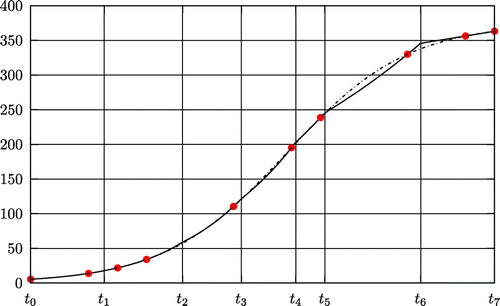
Table 3. Simulated data in data-set 2.
Table 4. Minimization results for the functional (18) for data set 2.
Figure 7. The dashed line indicates the exact solution of (Equation2121
21 ), the solid line is the derived solution and dots represent data points.
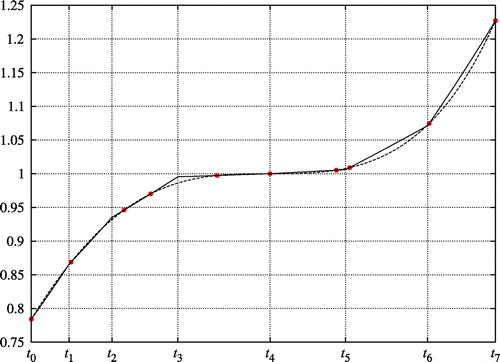
6.2 Data-set 2
Data-set 2 generates as random numbers in
and
by solving the following differential equation at
:
21
21 The generated data-set
is shown in Table . Data-set 2 considers seven subintervals (
), and the structure of subintervals is (1, 1, 1, 2, 2, 1, 2). In other words, the fourth, fifth and seventh subintervals have two data points, whereas the others, one data point. As depicted in Figure , the whole interval can be decomposed by three subgroups G1, G2 and G3. The first subgroup G1 has four subintervals and is classified as T2. In this case, there is no need to conduct the modified
-test because it is T2, and therefore the existence of time nodes and corresponding parameters are always guaranteed. On the other hand, G2 and G3 have two and three subintervals, respectively, and both are classified as T1. Therefore, the modified
-test needs to be conducted. In G2, however, the value of
is negative, implying the nonexistence of
. Accordingly, it is not possible to determine a piecewise constant parameter function
satisfying (2) with this structure.
Consider another structure of subintervals. Suppose that seven subintervals () are given and the structure of subintervals is (1, 1, 2, 1, 2, 1, 2). In this case, the third, fifth and seventh subintervals have two data points, whereas the others, one data point. The whole interval can be decomposed into three subgroups G1, G2 and G3. As in the cases of the other data-sets, the modified
-test needs to be conducted for G2 and G3, which are of T1 type. Here simple calculations indicate that the modified
-test is successful, and therefore the optimal parameter function can be calculated. Table shows the results. In addition, the
error between the derived and exact solutions of (Equation21
21
21 ) is
Figure shows the graph of the solutions with estimated time nodes and parameters.
7 Funding
This research was supported by NRF of Korea [grant number 2011-0000344], [grant number 2009-0065241], [grant number 2008-C00043].
References
- Beck JV, Arnold KJ. Parameter estimation in engineering and science. New York (NY): John Wiley & Sons; 1977.
- Tarantola A. Inverse problem theory. Methods for data fitting and model parameter estimation. Amsterdam: Elsevier; 1987.
- Banks HT, Bihari KL. Modelling and estimating uncertainty in parameter estimation. Inverse Probl. 2001;17:95–111.
- Banks HT, Fitzpatrick BG. Statistical methods for model comparison in parameter estimation problems for distributed systems. J. Math. Biol. 1990;28:501–527.
- Hvala N, Zec M, Strmc̆nik S. Non-linear model parameter estimation-estimating a feasible parameter set with respect to model use. Math. Comput. Modell. Dyn. Syst. Meth. Tools Appl. Eng. Related Sci. 2008;14:587–605.
- Martinsons CD. Optimal parameterization of a mathematical model for solving parameter estimation problems. Inverse Probl. Sci. Eng. 2005;13:109–131.
- Seber GAF, Wild CJ. Nonlinear regression. Hoboken (NJ): Wiley-Interscience; 2003.
- Beverton RJH, Holt SJ. A review of the lifespans and mortality rates of fish in nature, and their relation to growth and other physiological characteristics. Chichester: John Wiley & Sons Ltd; 2008. p. 142–180.
- Cren EDL. The length-weight relationship and seasonal cycle in gonad weight and condition in the perch (perca fluviatilis). J. Animal Ecol. 1951;20:201–219.
- White P, Kalff J, Rasmussen J, Gasol J. The effect of temperature and algal biomass on bacterial production and specific growth rate in freshwater and marine habitats. Microb. Ecol. 1991;21:99–118.
- Aiello WG, Freedman H. A time-delay model of single-species growth with stage structure. Math. Biosci. 1990;101:139–153.
- Aiello WG, Freedman HI, Wu J. Analysis of a model representing stage-structured population growth with state-dependent time delay. SIAM J. Appl. Math. 1992;52:855–869.
- Gourley SA, Kuang. Y. A stage structured predator-prey model and its dependence on maturation delay and death rate. J. Math. Biol. 2004;49:188–200.
- Gurney WSC, Nisbet RM. Fluctuation periodicity, generation separation, and the expression of larval competition. Theoret. Population Biol. 1985;28:150–180.
- Nisbet RM, Blythe SP, Gurney WSC, Metz JAJ. Stage-structure models of populations with distinct growth and development processes. IMA J. Math. Appl. Med. Biol. 1985;2:57–68.
- Rockafellar RT. The multiplier method of Hestenes and Powell applied to convex programming. J. Optim. Theory Appl. 1973;12:555–562.
- Gauze GF. The struggle for existence. Baltimore (MD): The Williams & Wilkins company; 1934.
Details of calculation in Lemma 4.3

